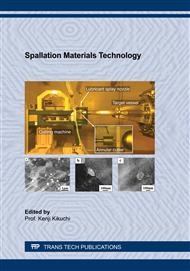[1]
S.J. Zinkle, J.L. Boutard, D.T. Hoelzer, A. Kimura, R. Lindau, G.R. Odette, M. Rieth, L. Tan, H. Tanigawa, Nucl. Fusion. 57 (2017) 92005 (17pp).
DOI: 10.1088/1741-4326/57/9/092005
Google Scholar
[2]
F.A. Garner et al., J. Nucl. Mater 276 (2000) 123-142.
Google Scholar
[3]
X. Wang et al., Scripta Materialia 112 (2016) 9–14.
Google Scholar
[4]
D.S. Gelles, J. Nucl. Mater 233-237 (1996) 293-298.
Google Scholar
[5]
B.H. Sencer, J.R. Kennedy, J.J. Cole, S.A. Maloy, F.A. Garner, J. Nucl. Mater. 393 (2009) 235.
Google Scholar
[6]
Y.E. Kupriiyanova et al., J. Nucl. Mater 468 (2016) 264-273.
Google Scholar
[7]
W.G. Johnston, T. Lauritzen, J.H. Rosolowski, A.M. Turkalo, in: Effects of Radiation on Materials, 11th Conference, ASTM STP 782 (1982) 809-823.
Google Scholar
[8]
F.A. Garner, J. Nucl. Mater. 117 (1983) p.177.
Google Scholar
[9]
M. Klimenkov, A. Möslang, E. Materna-Morris, J. Nucl. Mater 453 (2014) 54–59.
Google Scholar
[10]
G. Was, Challenges to the use of ion irradiation for emulating reactor irradiation. Journal of Materials Research, 30(9), (2015) 1158-1182.
DOI: 10.1557/jmr.2015.73
Google Scholar
[11]
S. E. Donnelly, The density and pressure of helium in bubbles in implanted metals: A critical review, Radiation Effects, 90:1-2 (1985) 1-47.
DOI: 10.1080/00337578508222514
Google Scholar
[12]
K. Farrell, P. J. Maziasz, E. H. Lee and L. K. Mansur, Radiat. Eff. 78 1-4 (1983) 277-295.
Google Scholar
[13]
H. Trinkaus, Radiat. Eff. 78 (1983) 189–211.
Google Scholar
[14]
N.M. Ghoniem, M.L. Takata, J. Nucl. Mater. 105 (1982) 276–292.
Google Scholar
[15]
H. Ullmaier, Radiat. Radiat. Eff. 78 (1983) 1–10.
Google Scholar
[16]
L.K. Mansur, W.A. Coghlan, J. Nucl. Mater. 119 (1983) 1–25.
Google Scholar
[17]
S. Sharafat, N.M. Ghoniem, Radiat. Eff. Defects Solids. 113 (1990) 331–358.
Google Scholar
[18]
H. Trinkaus, B.N. Singh, J. Nucl. Mater 323 (2003) 229-242].
Google Scholar
[19]
Ch. Fu, F. Willaime, Phys. Rev. B. 72 (2005) 064117-3.
Google Scholar
[20]
C. Dethloff, Modeling of Helium Bubble Nucleation and Growth in Neutron Irradiated RAFM Steels, KIT scientific publishing, (2012).
DOI: 10.1016/j.jnucmat.2011.12.025
Google Scholar
[21]
K. Farrell, Radiat. Eff. 53 (1980) 175-194.
Google Scholar
[22]
T. Troev, E. Popov, P. Staikov, N. Nankov, Phys. Status Solidi C 6 (11) (2009) 2373–2375.
DOI: 10.1002/pssc.200982129
Google Scholar
[23]
Z. Tong, Y. Dai, J. Nucl. Mater 398 (2010) 43-48.
Google Scholar
[24]
R.E. Stoller, G.R. Odette, J. Nucl. Mater 131 (1985) 118-125.
Google Scholar
[25]
C. Dethloff, E. Gaganidze, V.V. Svetukhin, J. Aktaa, J. Nucl. Mater 426 (2012) 287-297.
Google Scholar
[26]
G.R. Odette, R.E. Stoller, J. Nucl. Mater 122 (1984) 514-519.
Google Scholar
[27]
X. Jia, Y. Dai, J. Nucl. Mater 356 (2006) 105-111.
Google Scholar
[28]
P.B. Johnson, R.W. Thomson, K. Reader, J. Nucl. Mater 273 (1999) 117-129.
Google Scholar
[29]
Y. Dai, G.R. Odette, T. Yamamoto, The Effects of Helium in Irradiated Structural Alloys, Elsevier Inc., 2012, https://doi.org/10.1016/B978-0-08-056033- 5.00006-9.
Google Scholar
[30]
V. Krsjak, J. Kuriplach, T. Shen, V. Sabelova, K. Sato, Y. Dai, J. Nucl. Mater. 456 (2015) 382-388.
DOI: 10.1016/j.jnucmat.2014.10.014
Google Scholar
[31]
M. Hernández-Mayoral, M. J. Caturla, Microstructure evolution of irradiated structural materials in nuclear power plants, Understanding and Mitigating Ageing in Nuclear Power Plants Materials and Operational Aspects of Plant Life Management (Plim), Woodhead Publishing Series in Energy (2010) 189-235.
DOI: 10.1533/9781845699956.2.189
Google Scholar
[32]
P. Hautojärvi, C. Corbel, in: Positron Solid State Physics, Proceedings of the International School of Physics, Enrico Fermi, Course XX, Varenna, (1993).
Google Scholar
[33]
V. Krsjak, J. Kuriplach, C. Vieh, L. Peng, Y. Dai, J. Nucl. Mater. 504 (2018) 277–280.
Google Scholar
[34]
N. de Diego et al. / Acta Materialia 53 (2005) 163–172.
Google Scholar
[35]
G. Brauer, M. Sob and J. Kocik, Positron annihilation study of radiation damage in neutron irradiated reactor pressure vessel steels, Report ZfK-703 (April 1990), Zentralinstitut fiir Kernforschung Rossendorf.
Google Scholar
[36]
M.J. Puska, R.M. Nieminen, J. Phys. F: Met. Phys. 13 (1983) 333.
Google Scholar
[37]
A.P. Seitsonen, M.J. Puska, R.M. Nieminen, Phys. Rev. B 51 (1995) 14057.
Google Scholar
[38]
J. Kuriplach, A.L. Morales, C. Dauwe, D. Segers, M. Sob, Phys. Rev. B 58 (1998) 10475.
Google Scholar
[39]
V. Sabelova V. Krsjak, J. Kuriplach, M. Petriska, V. Slugen, J. Simeg Veternikova, J. Nucl. Mater. 450 (2014) 54–58.
Google Scholar
[40]
V. Sabelova V. Krsjak, J. Kuriplach, Y. Dai, V. Slugen, J. Nucl. Mater. 458 (2015) 350–354.
Google Scholar
[41]
T. Troev, E. Popov, P. Staikov, N. Nankov, T. Yoshiie, Nucl. Instrum. MethodsPhys. Res. Sect. B Beam Interact. Mater. Atoms 267 (2009) 535-541.
DOI: 10.1016/j.nimb.2008.11.045
Google Scholar
[42]
R.E. Stoller, Yu.N. Osetsky, J. Nucl. Mater 455 (2014) 258–262.
Google Scholar
[43]
Y. Dai, V. Krsjak, V. Kuksenko, R. Schäublin, J. Nucl. Mater. 511 (2018) 508–522.
Google Scholar
[44]
C. Vieh, Hardening induced by radiation damage and helium in structural materials, These No 6490, EPFL Lausanne, (2015).
Google Scholar
[45]
Y. Wu G.R. Odette T. Yamamoto J. Ciston P. Hosemann, An Electron Energy Loss Spectroscopy Study of Helium Bubbles in Nanostructured Ferritic Alloys, Semiannual Progress Report DOE/ER-0313/54.
Google Scholar
[46]
Y.N. Osetsky, R.E. Stoller, J. Nucl. Mater. 465 (2015) 448-454.
Google Scholar
[47]
V. Krsjak, C. Vieh, and Y. Dai, Microstructural aspects of helium bubbles formation in ferritic martensitic steels, AIP Conference Proceedings 2182, 050026 (2019); https://doi.org/10.1063/1.5135869.
DOI: 10.1063/1.5135869
Google Scholar
[48]
K. Morishita, R. Sugano, B.D. Wirth, T. Diaz de la Rubia, Nucl. Instruments Methods Phys. Res. Sect. B Beam Interact. with Mater. Atoms. 202 (2003) 76–81.
DOI: 10.1016/s0168-583x(02)01832-3
Google Scholar
[49]
K. Wang, Embrittlement induced by the synergistic effects of radiation damage and helium in structural steels, These No 6824, EPFL Lausanne, (2015).
Google Scholar
[50]
V. Krsjak, J. Degmova, S. Sojak, V. Slugen et al., J. Nucl. Mater 499 (2018) 38-46.
Google Scholar
[51]
V. Krsjak, J. Degmova, T. Shen, E. Korpas, S. Sojak, P. Noga, B. Li, V. Slugen, F. Garner, Positron annihilation study of helium bubble nucleation in oxide dispersion strengthened ferritic steels, Unpublished manuscript.
DOI: 10.1016/j.jmst.2021.08.004
Google Scholar


